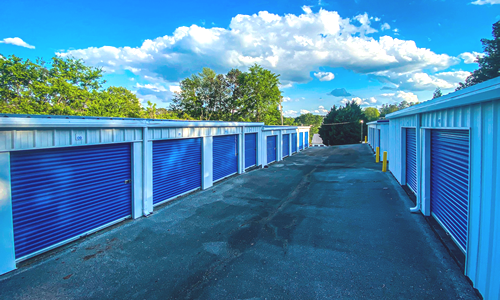Self Storage Tips, Tricks, and Rules to Live By
Tips Everyone Should Know About Storing Their Stuff!

Storage Unit Tips and Tricks: A Complete Guide
Storing your belongings in a storage unit can be an excellent solution for decluttering, moving, or keeping seasonal items safe. However, the success of your storage experience largely depends on how well you prepare and organize your items. This guide will help you maximize your storage space while keeping your belongings in excellent condition.
Part 1: Non-Climate Controlled Storage Units
Non-climate controlled units are typically more affordable but require extra preparation since your items will be exposed to temperature fluctuations and humidity changes.
What to Store
Ideal items: Furniture (metal, plastic), garden tools, sporting equipment, holiday decorations, books in plastic containers, non-perishable items
Avoid storing: Electronics, photographs, important documents, musical instruments, antiques, leather goods, or anything sensitive to temperature changes
Preparation Tips
Furniture Protection:
- Disassemble large pieces when possible to save space
- Wrap wooden furniture in moving blankets or plastic wrap
- Place furniture on pallets or blocks to avoid direct floor contact
- Remove or secure loose parts and hardware in labeled bags
Moisture Prevention:
- Use moisture absorbers (silica gel packets, DampRid) throughout the unit
- Wrap items in plastic sheeting, but ensure some ventilation to prevent condensation
- Never store items in direct contact with concrete floors
- Consider using vapor barriers under items
- Use plastic bins instead of cardboard boxes when possible
- If using cardboard, choose new, sturdy boxes
- Seal boxes completely with quality packing tape
- Label everything clearly with waterproof markers
Organization Techniques
- Create aisles for easy access to items in the back
- Store frequently needed items near the front
- Use vertical space with sturdy shelving units
- Keep an inventory list with photos
- Map out your unit layout for quick reference
- Seasonal Considerations
- Visit your unit periodically to check for moisture or pest issues
- Rotate seasonal items to keep current-season items accessible
- Consider the expansion and contraction of materials in temperature changes
Part 2: Climate Controlled Storage Units
Climate controlled units maintain consistent temperature and humidity levels, making them ideal for sensitive items but requiring different storage strategies.
What to Store
Perfect for: Electronics, photographs, documents, artwork, musical instruments, antiques, wine, collectibles, leather goods, wooden furniture, fabric items, medical supplies
Temperature range: Typically maintained between 55-85°F with humidity control
Preparation Tips
Electronics and Appliances:
- Clean thoroughly before storage
- Remove batteries to prevent corrosion
- Wrap in anti-static materials or original packaging
- Store upright when possible (refrigerators, washers)
- Coil cords loosely to prevent damage
- Use acid-free boxes and archival-quality materials
- Store photos in photo-safe albums or boxes
- Keep documents in file folders within sealed containers
- Consider digitizing important documents as backup
- Use desiccant packets for extra moisture protection
- Wrap paintings in acid-free tissue paper and bubble wrap
- Store paintings vertically, never flat
- Use custom crates for valuable pieces
- Keep collectibles in original packaging when possible
- Maintain detailed inventory with photographs
General Tips & Advanced Organization
Shelving Systems:
- Invest in quality metal shelving (avoid wood which can warp)
- Use clear, stackable containers for easy identification
- Label shelves and containers systematically
- Create zones for different categories of items
Air Circulation:
- Don't pack items too tightly against walls
- Leave space between boxes for air flow
- Use fans if allowed to promote circulation
- Avoid sealing the unit completely airtight
Temperature Sensitive Items:
- Store wine bottles on their sides in wine racks
- Keep musical instruments in hard cases
- Allow electronics to acclimate to room temperature before use
- Store vinyl records vertically, never flat
Maintenance and Monitoring
- Check on your unit monthly
- Maintain your inventory list
- Rotate items if needed for preservation
- Monitor for any signs of pest activity
- Keep insurance documents updated
- Universal Best Practices for Both Unit Types
Security Measures
- Use a high-quality disc lock or cylinder lock
- Never share your access code or key
- Avoid storing items of extreme sentimental or monetary value
- Take photos of valuable items for insurance purposes
- Consider additional insurance coverage
Cost-Saving Tips
- Compare prices and promotions from multiple facilities
- Consider sharing a larger unit with family or friends
- Pay annually for discounts when available
- Choose the right size - too small wastes money on multiple moves, too large wastes money on unused space
Moving Day Strategy
- Pack a "first day" box with essentials
- Load heavy items first, lighter items on top
- Use furniture as storage (drawers, wardrobes) to maximize space
- Bring basic tools for any last-minute adjustments
- Take a final photo of your unit layout
Long-term Storage Considerations
- Review and declutter annually
- Update your inventory regularly
- Consider donating items you haven't needed
- Plan for easy access to seasonal items
- Budget for potential unit size changes
Conclusion
Whether you choose climate controlled or non-climate controlled storage, proper preparation and organization are key to a successful storage experience. Climate controlled units offer superior protection for sensitive items but come at a higher cost, while non-climate controlled units are budget-friendly for less sensitive belongings.
Remember that the investment in proper packing materials and organization will pay off in the long run by protecting your belongings and making retrieval much easier. Take time to plan your storage strategy, and don't hesitate to ask facility staff for advice specific to your location's climate conditions.
By following these guidelines, you'll ensure your stored items remain in excellent condition and your storage unit serves as a valuable extension of your living space.

